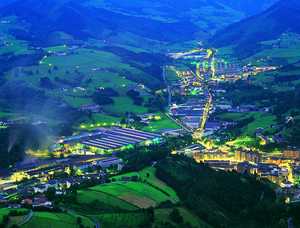gipuzkoakultura.net




If Patricio Echeverría was the driving force in Legazpi, Compañía Auxiliar de Ferrocarriles was the equivalent for the nearby town of Beasain. The company's origins date back to 1860 and the San Martin de Urbieta Iron Factory. During its first two years of operation, it only had two puddling furnaces and a cylinder rolling mill but the first charcoal-burning blast furnaces were added in 1862 and 1865.

Coaches and other rail parts formed the company's chief output and in order to corner the market and compete at an advantage, a new company, the Sociedad Española de Construcciones Metálicas, was founded in Bilbao in March 1901. A few months later work began on the building of a vast new manufacturing complex, the Beasain Coach Factory, on the site of the old San Martín works. On 1 February 1905 the company delivered its first order and just three years later it was already employing nearly 900 workers. (LEGORBURU FAUS, 1996).
Like Patricio Echeverría, the firm benefited enormously from Spain's neutrality during the First World War. Indeed, demand was so great that it led to problems when the firm was incapable of meeting all its orders and had to face penalisations as a result. This situation was resolved in 1917 with the renting of the coach factory by Compañía Auxiliar de Ferrocarriles, S.A., a firm which had been founded on 4 March of that year with an initial capital of three million pesetas. This transitory period lasted until 1925, when it finally took over the old Beasain Coach Factory. The registered activity of the new company was
the construction, purchase, sale and rental of coaches and any other materials that may serve for the transport and operation of railways and tramways.
The facilities taken over by the newly created C.A.F. were essentially obsolete, with outmoded mechanical equipment. Productivity had to be increased and costs reduced to a minimum. The firm started by modernising the casting workshop, reducing fuel consumption, incorporating a Siemens Martin furnace and finally downsizing the workforce.
The 1920s saw rapid growth, motivated by growing demand from both domestic and foreign markets. The factory at Beasain produced all types of rolling stock: electric locomotives, railcars and trams, and catered to the state railway network, benefiting from the strong protectionist measures of the time. This sustained growth allowed the company to upgrade its facilities for manufacturing tyres for rail wheels, building new workshops for forging and rolling monobloc wheels.
But between 1931 and 1936 demand for coaches fell dramatically. The company had no alternative but to diversify. The result was a new line for manufacturing agricultural machinery and automobile parts. In addition, because of the saturation of the Spanish market, C.A.F. began to export to South America-Argentina and Uruguay-and the Near East, as well as making inroads on the Belgian and French markets.
After the Spanish Civil War, the company faced the problems of international isolation and the difficulties of post-war reconstruction. The 1950s saw new deregulation and development, which was to continue in the 1960s and 1970s. The result was the complete modernisation of the Beasain plant. In 1971 the firm Construcciones y Auxiliar de Ferrocarriles was set up, the culmination of a long process of business concentration. Using its initials C.A.F.-which have been maintained from 1917 right down to the present day-its coaches, trucks and locomotives travel the railways of the world.